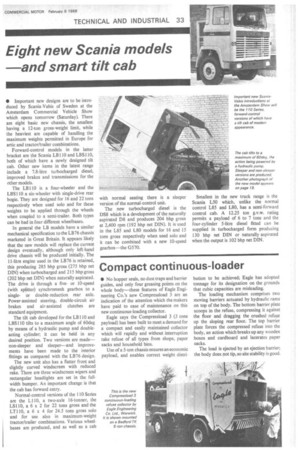Eight new Scania models and smart tilt cab
Page 35

If you've noticed an error in this article please click here to report it so we can fix it.
• Important new designs are to be introduced by Scania-Vabis of Sweden at the Amsterdam Commercial Vehicle Show which opens tomorrow (Saturday). There are eight basic new chassis, the smallest having a 12-ton gross-weight limit, while the heaviest are capable of handling the maximum weights permitted in Europe for artic and tractor/trailer combinations.
Forward-control models in the latter bracket are the Scania LB110 and LBS110, both of which have a newly designed tilt cab. Other new items in the latest range include a 7.8-litre turbocharged diesel, improved brakes and transmissions for the other models.
The LB110 is a four-wheeler and the LBS110 a six-wheeler with single-drive rear bogie. They are designed for 16 and 22 tons respectively when used solo and for these weights to be applied through the wheels when coupled to a semi-trailer. Both types can be had in four different wheelbases.
In general the LB models have a similar mechanical specification to the LB76 chassis marketed in Great Britain. It appears likely that the new models will replace the current design eventually, although only left-hand drive chassis will be produced initially. The 11-litre engine used in the LB76 is retained, this producing 285 bhp gross (275 bhp net DIN) when turbocharged and 215 bhp gross (202 bhp net DIN) when naturally aspirated. The drive is through a fiveor 10-speed (with splitter) synchromesh gearbox to a singleor double-reduction rear axle. Power-assisted steering, double-circuit air brakes and air-assisted clutches are standard equipment.
The tilt cab developed for the LB110 and LBS110 tilts to a maximum angle of 60deg by means of a hydraulic pump and doubleacting cylinder; it can be held in any desired position. Two versions are madenon-sleeper and sleeper—and improvements have been made to the interior fittings as compared with the LB76 design.
The new unit also has a flatter front and slightly curved windscreen with reduced rake. There are three windscreen wipers and rectangular headlights are set in the fullwidth bumper. An important change is that the cab has forward entry.
Normal-control versions of the 110 Series are the L110, a two-axle 16-tonner, the LS110, a 6 x 2 for 22 tons gross and the LT110, a 6 x 4 for 24.5 tons gross solo and for use also in maximum-weight tractor/trailer combinations. Various wheelbases are produced, and as well as a cab with normal seating there is a sleeper version of the normal-control unit.
The new turbocharged diesel is the DS8 which is a development of the naturally aspirated D8 and produces 204 bhp gross at 2,400 rpm (192 bhp net DIN). It is used in the L85 and L80 models for 16 and 15 tons gross respectively when used solo and it can be combined with a new 10-speed gearbox—the G570. Smallest in the new truck range is the Scania L50 which, unlike the normal control L85 and L80, has a semi-forward control cab. A 12.25 ton g.v.w. rating permits a payload of 6 to 7 tons arid the four-cylinder 5-litre diesel fitted can he supplied in turbocharged form producing 130 bhp net DIN or naturally aspirated when the output is 102 bhp net DIN.




































































































